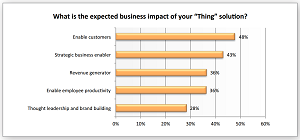News
Survey: IoT Development Gets Down to Business in 2015
- By David Ramel
- January 14, 2015
Software development tools company Embarcadero Technologies Inc. today announced survey results that indicate 2015 will be a big year for developing business-related Internet of Things (IoT) solutions.
The "Software for the Internet of Things (IoT) Developer Survey" (registration required) was conducted online last month by Dimensional Research, which polled 1,040 developers involved with creating IoT solutions. Embarcadero said the survey's goal was to understand the current status of
IoT projects, what drives them and how developers are using new capabilities to deliver solutions.
The IoT is defined by Wikipedia as pertaining to the "advanced connectivity of devices, systems, and services." Touching on major industry disruptive trends such as cloud computing, mobility and Big Data analytics, IoT has for the past several months seen an explosion in developer interest as companies seek to connect devices to provide data for business initiatives, automate operations and myriad other uses.
Survey results show the focus of developing for "things" (defined here as devices and sensors of all kinds, excluding phones, tablets, laptops, printers and servers) is changing from the consumer space to business.
Embarcadero said the survey "reveals that 77 percent of development teams will have IoT solutions in active development in 2015 with almost half (49 percent) of IoT developers anticipating their solutions will generate business impact by the end of 2015, compared to only 12 percent in 2014."
The survey revealed that most IoT development contains a business aspect. Half of IoT solutions are for business only (HVAC sensors, inventory control and so on) while 34 percent will be built for business and consumer purposes (smart buildings, vehicle operation and so on) and only 16 percent will exclusively target consumers (children tracking, home health monitoring and so on).
 [Click on image for larger view.]
What's driving IoT development? (source: Embarcadero Technologies Inc.)
[Click on image for larger view.]
What's driving IoT development? (source: Embarcadero Technologies Inc.)
The company said highlights of the survey include:
- Half of things development is driven directly by customer demand.
- 71 percent of things data will move between devices and servers.
- 72 percent of things will communicate using multiple technologies.
- 49 percent of things will connect to cloud services.
- Android and Windows Desktop will be the top OSes connected to by things.
- 97 percent of things will accept non-traditional input (sensors, GPS, line of site and so on).
- 37 percent of things will present information in non-traditional ways (virtual reality, haptic, audible, environmental change and so on).
"These survey results confirm that IoT is crossing over from consumer gadgets to business productivity and customer engagement," said company exec Michael Swindell in a statement. "In the consumer space, individuals connect to IoT typically through a single personal mobile device, with the IoT experience encircling the user.
"However, with business solutions, IoT includes users and encircles the business and enterprise assets. The IoT-connected applications developers build for the enterprise are essential to connect the disparate parts of a distributed IoT business solution -- from mobile devices, to wearables and sensors, to cloud and on-premises enterprise back-ends. Software developers will clearly play a pivotal role in driving IoT innovation and business adoption in 2015 and beyond."
The survey results jive with other industry sources, such as Clive Howard who last fall wrote an article here titled, "Debunking the Top 3 Internet of Things (IoT) Development Myths." Myth No. 1, Howard said, was the consumerization angle.
"There will of course be consumer applications of IoT that will bring about changes in behavior and interaction, but it will be the industrial ones that will most likely have the biggest impact on the world at large," Howard said.
About the Author
David Ramel is an editor and writer at Converge 360.